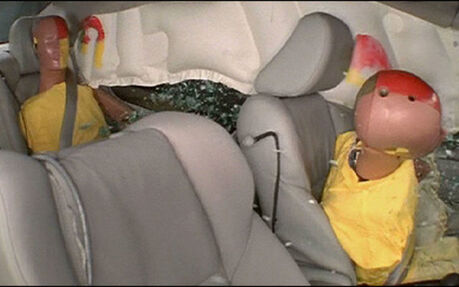Acura achieves historic first in crash test ratings
For the first and only time in the history of Insurance Institute for Highway Safety (IIHS) testing, an automobile nameplate has earned the prestigious TOP SAFETY PICK rating for every vehicle in its entire line-up. To accomplish this safety milestone, all 2009 Acura luxury sedans and SUVs received the highest possible rating in each IIHS crash test and feature the Acura Vehicle Stability Assist™ (VSA®) electronic stability control system as standard equipment.
"TOP SAFETY PICK winners are the top performers in tough front, side, and rear crash tests, and they have electronic stability control, a crucial technology that can help drivers avoid many crashes altogether," says Institute president Adrian Lund. "Acura's achievement means that no matter which Acura model buyers choose, they're getting state-of-the-art protection for the most common kinds of real-world crashes." To complete the Acura feat, earlier today the IIHS announced that the all-new 2009 Acura TL performance luxury sedan garnered its top safety rating of "GOOD" for each category, including Frontal Offset Crash Test, Side Impact Collision Evaluation (SICE) and Rear Crash Protection. The completely redesigned 2009 TL went on sale in September and is Acura's top selling performance luxury sedan.
"With every Acura vehicle we build, safety is at the forefront throughout the entire design process," said John Mendel, executive vice president of automobile operations. "We are extremely proud that Acura is the first and only nameplate to ever earn this safety distinction." In addition, all 2009 Acura vehicles have earned top governmental crash test ratings from the National Highway Traffic Safety Administration (NHTSA*) for NCAP Frontal Crash tests-the most common form of vehicle accident.
The top crash safety ratings are a direct result of Acura's "Safety Through Innovation" initiative that is based on the brand's commitment to leadership in safety. The initiative's goal is for all Acura models to provide a high level of occupant protection along with injury mitigation to pedestrians, as well as increased crash compatibility with other vehicles, regardless of size or price. For 2009, all Acura models include as standard equipment the Advanced Compatibility Engineering™ (ACE™) body structure along with a host of other standard safety equipment including Vehicle Stability Assist™ (VSA®), anti-lock braking system (ABS), dual-stage/dual-threshold front airbags, side airbags with front passenger Occupant Position Detection System (OPDS), active head restraints for front seats, front seatbelts with automatic tensioning system and load limiters, Tire Pressure Monitoring System (TPMS) and Daytime Running Lights (DRL).
Acura's ACE™ body structure is designed to help absorb the energy of a frontal crash, while also helping to minimize the potential for an "under-ride" or "over-ride" phenomenon that can occur during frontal impact with a significantly larger, smaller, higher or lower vehicle. ACE™ channels frontal crash energy to both upper and lower structural elements, including the floor frame rails, side sills and A-pillars. These specially engineered load pathways help distribute frontal impact forces through a greater percentage of the vehicle's total structure and away from the passenger compartment. Acura engineers have the advantage of being able to utilize two ultra-sophisticated crash test facilities, including the world's first indoor multi-directional car-to-car crash testing facility, located in Tochigi, Japan. This facility has played a crucial role in the development of enhanced designs for occupant and pedestrian safety as well as vehicle-to-vehicle compatibility.
Along with the Japan facility, Acura also conducts extensive safety testing on all U.S. developed models at the company's Automotive Safety Research Facility which is located in Raymond, Ohio. The facility features the world's first pitching test sled, which aids efficiency by enabling economical, repeatable and quick crash test simulations with certain interior safety components (such as seats and seatbelts) prior to conducting a crash test with an actual vehicle. It also features one of the world's highest resolution impact barriers, which enables precise measurement of the distribution of impact load forces on a vehicle allowing for even more advanced vehicle designs.
Acura has been the first to market on many safety technologies including: the first production vehicle in the U.S. to offer a 4-channel braking system; the first production vehicle with a passenger-side airbag with height and position sensors; the first car to have dual-stage driver- and passenger-side airbags; the first luxury SUV to receive a 5-Star crash safety rating from NHTSA; and the first production vehicle to offer Occupant Position Detection System (OPDS) that varies the deployment of the passenger side airbag depending on the occupant's body location.
As part of its commitment to improving safety for all road users, Acura has also led the U.S. industry in the application of features designed to reduce injuries to pedestrians in a collision- such as collapsible hood hinges and breakaway windshield wiper pivots, with a focus on reducing severe head injuries, which account for 60 percent of pedestrian fatalities. In addition, the company sought to better understand the dynamics of pedestrian collisions, thus it developed the POLAR II safety test dummy which is widely recognized as the world's most advanced pedestrian safety test dummy.
About IIHS
The IIHS is a not-for-profit organization that conducts independent testing to help reduce losses - deaths, injuries, and property damage - from crashes on the nation's highways, and provides its findings to automotive insurers. IIHS has been conducting vehicle testing since 1969, and while it conducts impact crash tests similar to those conducted by NHTSA, IIHS tests make use of offset barriers rather than full-vehicle-width barriers.
Based on post crash test analysis, IIHS rates crash safety using four ratings: Good, Acceptable, Marginal and Poor. IIHS also conducts other vehicle safety tests including low-speed bumper impact tests and seat headrest evaluations based on rear impact tests. IIHS information and vehicle ratings can be obtained by visiting www.iihs.org.
